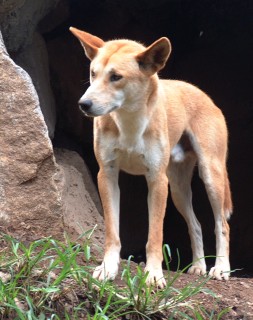
Typical dingo with erect ears,
tawny coat, white chest and paws.
Woolshed Park, Queensland.
|
Flora & Fauna Areas Australia Flora/Fauna Related Pages Australia HomeAustralia Newsletters Australia Cruising |
Australia Mammals
| Where to find wildlife in Australia. Just look around - It's everywhere. Koalas live on the east and south coast forests, high in the Eucalyptus trees. If you see a Koala Crossing sign on the highway, that's a sure give-away. Wild roos (and wallabies) frequent parks and grasslands in the evenings and early mornings. Snakes are harder to find, and if an Aussie sees it first, it's likely to be killed, as only 3 species are non-poisonous (they eat their prey whole). Insects, birds and bugs, plus lizards, geckos and skinks abound. Your guide book will list many nature parks (in addition to the famous Australia Zoo) throughout the country. A drive in the outback or national parks will yield the best wildlife if you camp and let the wombats, wallaroos and other creatures come to you. |
This section highlights some of the most common and interesting mammals of Australia, including the marsupials (like kangaroos and wallabies).
For other Australian animals (such as snakes, lizards and insects) see the Australia Fauna page. For birds, check out our Australia Birds 1 and Australia Birds 2 pages (we had too many to fit on just 1 page).
The world's Mammals can be divided into three categories (or in biology-speak, the Class Mammalia divides into 3 Subclasses) according to the way they bare young: placental mammals (Subclass Eutheria), marsupials (Subclass Marsupialia), and monotremes (Subclass Prototheria). All three of these subclasses are well represented in Australia.
 Typical dingo with erect ears, tawny coat, white chest and paws. Woolshed Park, Queensland. |
Placental mammals carry their young inside the mother's body until it is well developed and able to survive outside the mother. Before birth, the fetus receives nourishment through the blood vessels of the placenta which link the mother to the fetus. After birth, the young suckles at the mother's nipples to get milk. Placental mammals in Australia include what the rest of the world considers "normal" mammals such as marine mammals, rodents, dingos (wild dogs), camels (yes, wild camels!), bats, pigs, deer, etc.
Descended from the Indian wolf, the ancestors of today's dingo (Canis lupus dingo) were probably brought to Australia by seafaring Indonesians over 4,000 years ago. They are usually ginger-yellow with white patches on the chest, muzzle and paws. Other colors exist, and may show interbreeding with domestic dogs. Dingos form packs when hunting large prey such as kangaroos, but often scavenge alone. They are opportunistic carnivores, feeding on whatever is available, from insects to large mammals. They used to be plentiful throughout the continent (not on Tasmania) but are now not found in the heavily inhabited areas of southeastern and southwestern Australia. To keep the dogs out of agricultural lands a 9,600 km (about 6,000 mile) long "dingo fence" was erected several decades ago through New South Wales and Queensland.
The dingo is endangered due to interbreeding with domestic dogs and persecution by farmers. The dominant pair of the pack breeds once a year and the entire pack helps feed and raise the litter of 1 to 10 pups. We have seen wild dingos in the Queensland Outback and on Fraser Island. Animals that have been fed or allowed to scavenge in campgrounds can become aggressive. When walking on Fraser Island we were advised to carry a large stick (with which to defend ourselves vigorously if attacked), maintain eye contact, keep arms crossed in front, and back slowly away. Never run or wave your arms. Dingos howl to communicate with the pack. They rarely bark.
The other common placental mammals in Australia are bats (about 75 species), rodents (about 70 species), wild dogs, horses, pigs, deer and camels. Placental mammals also include the marine mammals.
| High in the Border Ranges between New South Wales and Queensland, in Lamington National Park, the Red-necked Pademelon (Thylogale thetis) is a common visitor to the campgrounds. Usually shy, these rainforest dwellers have learned to scavenge tidbits of food left by messy campers. This is one of many smaller "macropods", those marsupials with large feet, like the kangaroos, which hop. Pademelon males may weigh about 7 kg or 15 lbs, the females 4 kg or 9 lbs. They are brown/gray, with rufous neck, shoulder and forehead. The chin and chest are whitish. The tail is carried near horizontal when hopping fast. |
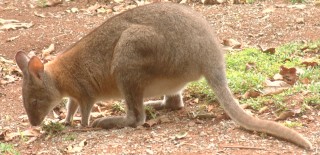 |
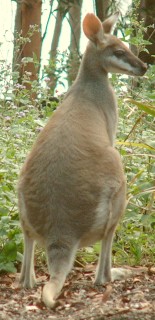 |
Wallabies are generally smaller than kangaroos, but the largest, the Red-necked Wallaby (Macropus rufogriseus) can attain weights of up to 27 kg or 60 lbs (males) and 17 kg or 37 lbs (females). They are native to coastal forest and scrub lands of eastern Australia and parts of the states of South Australia, Victoria and Tasmania. Mostly solitary, they browse on many plants, including ripening seedpods. Young can be born during any month, and they become independent at about 9 or 10 months. Red-necked wallabies make soft throaty growls and soft clucks (by the male when mating or the female to their young). The face stripe and pale tail are characteristic of this species. Notice the joey in the pouch in the right-hand photo. |
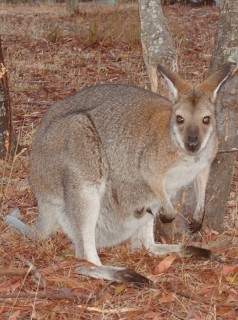 |
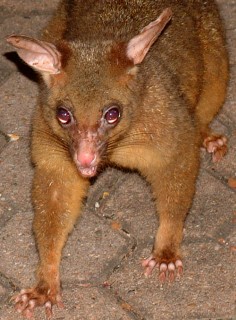
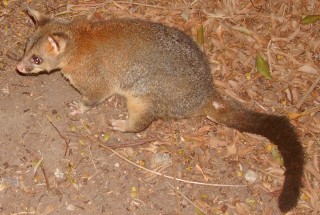 Common Brushtail Possums (Trichosurus vulpecula) can vary from gray-brown
with rufous tinges to all gray. Their tails are bushy and black. About the size of
large domestic cats, they are both terrestrial and arboreal. Nesting in tree
hollows or shelters created with brush and leaves, they can leap with agility from branch to
branch. We often saw them in the trees over the Brisbane River near large fruit
bats with whom they noisily disputed ownership of their branches with a long series of
rattling coughs and hisses. Possums are nocturnal,
social, and found in forests, scrub and gardens in most treed
environments around the coasts of Australia including the east coast
south to South Australia, Tasmania and in the far north and the
southwest. We saw dozens each summer night in Brisbane looking for
handouts and checking out the garbage bins. While they might look cute,
when they turn their face to you, you can see they have very sharp
teeth. Their claws can leave lasting impressions! Common Brushtail
possums (like all Australian possums) are marsupials, carrying one joey in
the pouch for about 4 or 5 months before it climbs out to ride
on the mother's back for the next 2 months.
Their natural diet consists of flowers, fruits and leaves. They eat
delicately with their paws while sitting upright. On the Bass Strait coast a black female
Mountain Brushtail Possum Trichosurus caninus (not pictured) had taken up residence
in the men's restroom on a beam over the urinals. She sure gave the men quite a fright the
first time they saw her, with her large glossy eyes staring down at them!
Common Brushtail Possums (Trichosurus vulpecula) can vary from gray-brown
with rufous tinges to all gray. Their tails are bushy and black. About the size of
large domestic cats, they are both terrestrial and arboreal. Nesting in tree
hollows or shelters created with brush and leaves, they can leap with agility from branch to
branch. We often saw them in the trees over the Brisbane River near large fruit
bats with whom they noisily disputed ownership of their branches with a long series of
rattling coughs and hisses. Possums are nocturnal,
social, and found in forests, scrub and gardens in most treed
environments around the coasts of Australia including the east coast
south to South Australia, Tasmania and in the far north and the
southwest. We saw dozens each summer night in Brisbane looking for
handouts and checking out the garbage bins. While they might look cute,
when they turn their face to you, you can see they have very sharp
teeth. Their claws can leave lasting impressions! Common Brushtail
possums (like all Australian possums) are marsupials, carrying one joey in
the pouch for about 4 or 5 months before it climbs out to ride
on the mother's back for the next 2 months.
Their natural diet consists of flowers, fruits and leaves. They eat
delicately with their paws while sitting upright. On the Bass Strait coast a black female
Mountain Brushtail Possum Trichosurus caninus (not pictured) had taken up residence
in the men's restroom on a beam over the urinals. She sure gave the men quite a fright the
first time they saw her, with her large glossy eyes staring down at them! |
At Wilson's Promontory National Park on the south coast of Victoria we were warned that each night the wombats come out to forage, and if food was left in our tents, they would slice their way in, destroying packs and tent to get at the food. We carefully took no food inside, but we did go out on a wombat "hunt" early one evening. Driving up the park road at dusk we passed dozens of furry brown lumps by the side of the road. The Common Wombat (Vombatus ursinus) is a large, thick-set animal which, as its Latin name implies, resembles a small, low-slung bear. Wombats graze on grasses, sedges and tubers, and are solitary and nocturnal. They live in burrows that may be over 20 meters (66') long, built by several generations of wombats. Every 2 years they produce one offspring which stays in the backwards facing pouch for about 6 to 9 months. The young one follows its mother on foot for another 10 months or so until it is independent. Wombats are very powerful, with strong claws and short, broad muzzles. Rumor has it that if you hit one with your car it is likely to tear the front of your car apart in retaliation! |
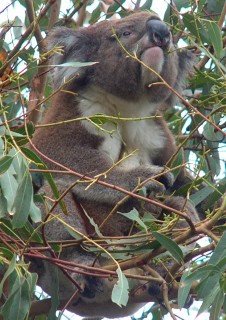
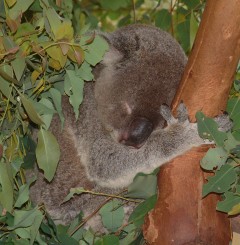 Koalas (Phascolarctos cinereus) are found only in eucalypt
forests on the eastern coast of Australia. In many places their survival
is in danger due to habitat destruction as new housing
developments spring up on this populated coastal region. The one at left was
eating leaves just a few feet
above our tent one night along the Great Ocean Road.
Koalas (Phascolarctos cinereus) are found only in eucalypt
forests on the eastern coast of Australia. In many places their survival
is in danger due to habitat destruction as new housing
developments spring up on this populated coastal region. The one at left was
eating leaves just a few feet
above our tent one night along the Great Ocean Road.Koalas sleep for about 20 out of 24 hours. The eucalypt leaves that make up their diet are very low in energy and hard to digest. A single young koala stays in its mother's pouch for about 6 months. Sitting day and night in eucalyptus trees, koalas have a thick padded bottom which makes for comfy seating on narrow branches. Koalas are arboreal, but climb down from trees when necessary. They are mostly solitary, except mothers and their young which stay together for up to 12 months after birth. The misnomer "koala bear" may come in part from their looks: sturdy bodies with no tail. But probably more likely the name comes from the growling, snorting, bellowing sound the males make during the spring and summer. Coming from North America where we backpack in bear territory, it was quite a shock to hear that sound when camped in Australia! |
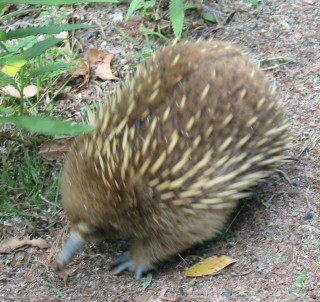 A short-beaked echidna in Tasmania |
Monotremes are fairly rare and lay soft-shelled eggs. When the young hatch they are blind and naked, with poorly developed hind legs. With its forelegs the newborn animal pulls itself to the mother's belly pouch where it suckles milk that oozes from pores (there are no nipples). Australia is home to two monotremes: the platypus and the echidna.
The Short-Beaked Echidna (Tachyglossus aculeatus) has spines that can stand erect like bristly armor. Echidnas are found all over Australia and live in burrows. The female echidna lays one egg which incubates for 10 days in her pouch. After hatching, the young one stays another 12 weeks in the pouch, nursing. When the bristles harden it lives in a burrow. Echidnas feed on termites, using their sharp claws to open the mounds, then extracting the termites with their long, sticky tongues. The Latin name means literally "spiny fast tongue". They are not very big: about 45 cm (18 inches) long. This photo of a short-beaked echidna dashing through the Tasmanian undergrowth courtesy s/v Zen.
The shy platypus (Ornithorhynchus anatinus) is amphibious and lives in quiet streams and lakes along the eastern coast of Australia. It has webbed feet, a tail like a beaver and a broad, duck-like bill which is very pliable and sensitive and is used to find shrimp, worms, insects and other food. The male has a poisonous spur on its hind ankle. Two eggs are laid in a stream burrow. They hatch after two weeks and the young stay to be nursed by the mother for another 4 or 5 months. The platypus was first sent to England for identification in 1798 and the naturalists there thought it was a hoax -- a combination of several animals preserved as one! These animals are smaller than most people think -- about 50 cm (20 inches) long. They are very hard to find in the wild, and even harder to photograph, being very shy.
Top Level: Home | Destinations | Cruising Info | Underwater | Boat Guests | Ocelot | Sue | Jon | Amanda | Chris | Site Map | Make a Comment
|
If our information is useful, you can help by making a donation |
Copyright © 2000‑ Contact: Jon and Sue Hacking -- HackingFamily.com, svOcelot.com. All rights reserved.